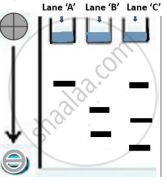Advertisements
Advertisements
प्रश्न
The DNA molecules of the same size were extracted from E. coli and Plasmodium vivax. It was discovered that both the DNA molecules had one target site each for the restriction enzyme Hind II. After being digested with Hind II, the DNA fragments were subjected to gel electrophoresis.
With reference to the diagram given below, identify the lanes that represent the DNA fragments of E. coli and Plasmodium vivax respectively. Justify your answer with a reason for each.

उत्तर
Lane A – DNA of E. coli
Lane B – DNA of Plasmodium vivax
Because the circular DNA of E. coli was cut to release just one fragment, while the linear DNA of Plasmodium was cut to release two fragments.
APPEARS IN
संबंधित प्रश्न
With the help of a neat and labelled diagram describe Watson and Crick's model of DNA.
Describe Meselson and Stahl’s experiment that was carried in 1958 on E.Coli. Write the conclusion they arrived at after the experiment.
Explain the process of DNA replication with the help of a schematic diagram.
Discuss the role the enzyme DNA ligase plays during DNA replication.
Draw a labelled diagram of a “replicating fork” showing the polarity.
Name two enzymes involved in the process of DNA replication along with their properties.
Okazaki fragments are seen during ______.
The origin of replication of DNA in E. coli is shown below, Identify the labelled parts (i),(ii), (iii), and (iv)

In which type of DNA replication of the two newly formed molecules, one is purely a new one and the other one is old?
During which phase of the cell cycle, does DNA replication take place?
